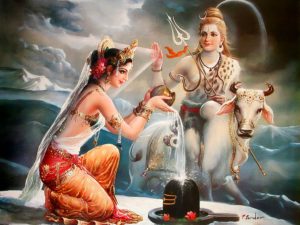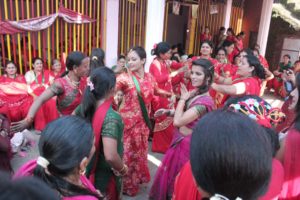The Monsoon Festival of Teej
The monsoon festival of Teej is one of the festivals that has a long and fascinating history and is one of the festivals that has not died out. As a living tradition, it receives much enjoyment and honour from the common people. The monsoon festival is a time to celebrate the bounty of nature with community activity, rituals, and customs.
The festival is celebrated on the third and fourth days of the month of Shrawan (July – August) for two days. It is called the green Teej because of the profusion of greenery during this period.
Honouring the goddess Parvati
The festival is held in honour of the goddess Parvati and women worship the goddess at this time. It was on this day that Parvati was reunited with her husband, Lord Siva, and stated that this day was holy and declared that anyone who invoked her on this day would be blessed with whatever their hearts desired.
 Women, during the festival, invoke the goddess and ask for long and happy marriages as well as peace and prosperity for their children. The women wear green, red or yellow dresses and paint their hands and feet in delicate and intricate designs with red henna. They sing songs that offer praise to the goddess Parvati. They then amuse themselves on swings afterwards. The celebration is of great importance to newly married women who takes the monsoon festival of Teej very seriously.
Women, during the festival, invoke the goddess and ask for long and happy marriages as well as peace and prosperity for their children. The women wear green, red or yellow dresses and paint their hands and feet in delicate and intricate designs with red henna. They sing songs that offer praise to the goddess Parvati. They then amuse themselves on swings afterwards. The celebration is of great importance to newly married women who takes the monsoon festival of Teej very seriously.
There are two themes to the monsoon festival; devotion to the goddess Parvati and the decoration of the female body. At this time, parents send gifts to their married daughters, which is called sindhara. This word derives from the Sanskrit word sringar which means the decoration of women and their charming beauty. These gifts include henna, bangles and a new dress. Unmarried daughters also receive gifts in the form of new clothing and other ways of self-decoration.
The tradition of the monsoon festival is that married daughters visit their parents on this day. The brothers will set up the swings. This is a day of families reunited, as Parvati was reunited with her husband and expresses happiness and enjoyment. This is then reflected in certain foods being cooked, new clothing, henna and putting on collyrium in the eyes and the tikka (red dot) on the forehead; this all symbolises a woman’s happy life. Wearing these items then has great significance for women, as Parvati is the patron goddess of women.
Putting henna on the feet and hands also has great significance; it is believed that it would bring good luck to the women and symbolises happiness. “The most popular designs made on this festival are those of lehariya (vertical lines of henna on palms), ghevar (the form of a round sweet dish specially made for this festival) and chaupar (design of a game of dice), besides other regular designs of flowers and leaves”.
Swinging has great importance in the monsoon festival.
According to mythology, swinging was done by the gods who wished to have fun and play as humans did. According to folklore, the gods came to swing during the monsoon festival.
Swinging is primarily done by women and girls, although small boys are allowed to sing as well. Songs are sung while women swing.
One goes, “On the branch of the magnolia tree I have put a swing/ Its rope is of silk, I have put a swing/ On the branch of the magnolia tree I have put a swing/ Its plank is of sandalwood, I have put a swing/ To swing on my swing, the Sun and Moon have come/ They have brought their queens to swing on my swing/ While swinging they stopped and said, we like red bangles/ Their mothers will buy them red bangles, I have put a swing …”
An important time for married couples
The monsoon festival Teej is an important time for married couples; they can forget about the hardships of housework and can enjoy themselves. As a monsoon festival, it is a time to welcome the rains and through this festival, they express their thanks to the god of rain, as rain is a blessing from the gods. The festival is held after the scorching heat of the summer months and marks the arrival of the rainy season.
During the third and fourth days of Shrawan there are processions where images of the goddess are taken from the palaces of Jaipur and Bundi. Made of silver and gold, these statues of the goddess are placed in silver palanquins and escorted by bedecked elephants, horses, bullocks, and camels, which are painted with beautiful designs and decorated with jewellery. These bedecked animals symbolise the king’s prosperity. The procession itself symbolises Parvati leaving her parents’ home for her husband’s. To watch the procession is believed to be propitious and lucky.
 The monsoon festival Teej instils new vigour and potency in the lives of the common people; it allows the Indian people to forget the problems of everyday life and release all the tension. Taking part in the festival increases social interaction with both family and friends and due to the long history, it allows the people to feel proud of their long history and traditions.
The monsoon festival Teej instils new vigour and potency in the lives of the common people; it allows the Indian people to forget the problems of everyday life and release all the tension. Taking part in the festival increases social interaction with both family and friends and due to the long history, it allows the people to feel proud of their long history and traditions.
When India gained independence in 1947, the government and the royal families of Jaipur, Bundi, and other cities combined efforts for this celebration. “Royalty provides the traditional image of the Goddess Parvati which is made of solid silver with many golds and jewel ornaments and fully clothed with a silk dress set consisting of a large petticoat, a headscarf, and a blouse embroidered with silver and gold thread and flowers, and so forth”. The government then organizes the street decoration, lighting, and manages law and order. The Department of Tourism has arranged this festival on a large scale in recent years to increase the popularity of it among non-Rajasthanis and foreign travellers.
The worship of the goddess Parvati is believed to be blessed with a happy marriage and family life; the celebration of the monsoon festival Teej will then bring a bumper harvest, a good life to come and symbolises the importance and continuation of happy family life.
Bibliography:
Bhatnager, Manju (1988) The Monsoon Festival Teej in Rajasthan, Asian Folklore Studies, Nanzan Institute for Religion and Culture.’






